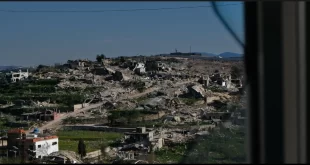August 5, 2017, CounterPunch – Vijay Prashad

On June 14, when United States Secretary of State Rex Tillerson went before the U.S. House Foreign Affairs Committee, Republican Congressman Ted Poe of Texas asked him about the government’s policy towards Iran. “Well,” Tillerson paused, “our Iranian policy is under development.” Poe asked Tillerson directly whether the U.S. government supported “a philosophy of regime change, peaceful regime change?” Tillerson responded: “Our policy towards Iran is to work toward support of those elements inside of Iran that would lead to a peaceful transition of that government. Those elements are there, certainly.”
In other words, Tillerson said, the U.S. government was committed to overthrowing the current government in Iran by peaceful means. What they mean by “peaceful” should not be taken lightly. No regime-change operation is ever peaceful. The Trump administration, meanwhile, is conducting an inter-agency review of the sanctions on Iran and of the various options available to the U.S. for action against Iran. These options include military force. There is belligerence in the air.
On July 17, a month later, President Donald Trump certified to Congress that Iran was in compliance with the international nuclear agreement, the Joint Comprehensive Plan of Action (JCPOA). The President has to conduct this certification exercise every 90 days. If the President does not certify the deal, then the U.S. Congress has 60 additional days to abandon the deal. The White House spokesperson said: “The President has made very clear that he thought this was a bad deal—bad deal for the United States.” Trump had wanted to refuse to certify the deal this time, and in the previous round. His national security team convinced him that this deal was valuable. One staff member said that Trump only signed on after he made it clear that the next time things would be different.
The American Right remains fundamentally opposed to the deal. John Bolton, former U.S. Ambassador to the United Nations, wrote recently that the nuclear deal “remains palpably harmful to American national interests”. Trump shares this view. They believe—against all evidence—that the deal allows Iran to retain its nuclear programme because international verification on the ground in Iran is “fatally inadequate”. Bolton urged Trump to make withdrawal from the nuclear deal the administration’s “highest priority”.
There is widespread enthusiasm in the White House to walk away from the deal and to use the full vitality of U.S. power to suffocate Iran. But elements in the U.S. intelligence services and in the diplomatic community are not keen on further confrontation with Iran. It would, they argue, confound U.S. policy in Iraq and against the Islamic State.
Iran complains that the U.S. has already violated the spirit of the JCPOA. In May, at the North Atlantic Treaty Organisation’s (NATO) Brussels headquarters, and in July, at the G20 meeting in Hamburg, Trump asked his European allies to stop doing business with Iran. This was done privately. When she was asked about it, Trump’s White House spokesperson Sarah Huckabee Sanders affirmed that Trump had told European leaders “to stop doing business with nations that sponsor terrorism, especially Iran”. The JCPOA, however, clearly prohibits “any policy specifically intended to directly and adversely affect the normalisation of trade and economic relations with Iran”. These are “sanctions” of a new kind.
The American Right recognises that the nuclear deal cannot be easily undone. European states do not have the appetite to return to a confrontation with Iran. The Europeans are eager to bring Iranian energy into their countries and they see the utility of engaging Iran on the multiple crises in West Asia. This is why U.S. Senator Bob Corker said that since Trump was “fully committed” to the American Right’s anti-Iran policy, new sanctions were needed to punish Iran for its “non-nuclear behaviour”. In other words, since Iran tested ballistic missiles, the U.S. has now placed new sanctions on 18 individuals, groups and networks.
The theory here is that the pressure on firms to stop doing business with Iran and new “non-nuclear” sanctions on Iran would encage the country once more. It would harden the positions of the Iranian leadership, Washington hopes, and drive it to do something provocative that would allow Trump to refuse to recertify the JCPOA in October. It would set the stage for a much more dangerous confrontation with Iran.
Iran’s President Hassan Rouhani said that Iran would “respond” to these sanctions, but he did not say how. What he did say was that Iran was grateful to the Europeans, China and Russia for “steadfastly employing perseverance to safeguard the JCPOA”. Do the Europeans, the Chinese and the Russians have the means to prevent a U.S. war? Will the Russians intervene militarily in Iran—as they did in Syria—to provide the country with a nuclear umbrella?
Message to Iran
The U.S. already has military bases on the doorstep of Iran—in Afghanistan, Bahrain, Oman, Pakistan, Qatar, Turkey, Turkmenistan, United Arab Emirates (UAE) and elsewhere. There are at least 125,000 U.S. troops on the edge of Iran and thousands of warships and aircraft at the ready.
Iran has long seen its ballistic missile programme as being a deterrent, however feeble, against this massive military encirclement. That the U.S. has decided to place new sanctions on Iran for its ballistic missile tests has sent a clear message to Iran: the U.S. will put as much pressure on Iran as possible to prevent it from developing anything like a deterrent capability.
Iran’s head of the Islamic Revolutionary Guards Corps, Major General Mohammad Ali Jafari, said that the U.S. should move its bases out of a 1,000-kilometre range from the Iranian borders. This would mean that the U.S. base at Shindand (Herat, Afghanistan), which is merely 200 km from the Iranian border, and the U.S. base in Bahrain, less than 100 km from Iran, would have to be removed. If the U.S. did not withdraw, Jafari intimated, then Iran would maintain its missile programme. The programme, he said, “is defensive and never would be subject to bargaining and negotiation at any level”.
Pressure on Iran from the U.S. is not only from the bases that ring the country but also on the ground in West Asia, from Iraq to Lebanon. Tillerson told Congress that the Trump administration was aware of “Iran’s continued destabilising presence in the region, their payment of foreign fighters, their export of militia forces in Syria, in Iraq, in Yemen, their support of Hizbollah”. The U.S., he said, was “taking action to respond to Iran’s hegemony”. There is a fantasy narrative in Washington, D.C., that Iran is the one that is aggressive in West Asia and that the U.S.—with its history of regime change and the presence of its military bases—is merely there to block Iranian ambitions.
Syria-Iraq border
Iran has indeed been eager to open up the land route from its border through Iraq to Syria. It would prefer to resupply the government of Bashar al-Assad through the much cheaper road that runs across the region than fly in military and civilian supplies. The road is open from Damascus to Syria’s border with Iraq and it is open from Iran’s border across Iraq. A U.S. base and U.S. proxies along the Iraq-Syria border are keen to create a buffer state to block Iran’s access to the road. This border post in south-eastern Syria is crucial and the two sides now face each other in a dangerous standoff.
The White House press secretary said that the U.S. had a “shared interest with Israel to make sure that Iran does not gain a foothold, military base-wise, in southern Syria”. Armed action by U.S. proxies, trained in a Central Intelligence Agency (CIA)-run camp in Jordan, against Syrian government troops backed by Iranian-led militias has been a flashpoint along the edge of southern Syria.
Meanwhile, along Lebanon’s border, tensions have risen over a potential Israeli strike against Hizbollah’s highly fortified positions. Israel has already been collaborating with various Syrian rebel groups, including Al Qaeda-backed groups, in the region near the occupied Golan Heights. Israeli aircraft have regularly been striking Syrian military targets to prevent any advance by the Syrian Army towards the de facto border with Israel. Israel would also like to expand its Golan Heights holdings and create a large buffer zone with Syria. These manoeuvres have been fully backed by the Trump White House.
Dangerous signals come from the new sanctions and from the hot wars between U.S. proxies, including Israel, and the Iranian-backed forces. When Trump was in Saudi Arabia in May, he suggested that the conflict between the U.S. and Iran was a “battle between good and evil”. Religious language such as this evokes the words of former President George W. Bush before he launched the illegal war on Iraq in 2003. It is Iran, Trump suggested, that “spreads destruction and chaos” in the region. This came the day after Iran re-elected its moderate President, and along the same time as the U.S. pledged to sell Saudi Arabia, a country spreading destruction and chaos in Yemen, arms worth $110 billion.
There is an appetite for war in the Trump White House and amongst its Israeli and Saudi partners. The war this time will be against Iran. If West Asia is in chaos now, there is no adequate word to describe its fate if that full-scale war actually begins.
 Syria Support Movement solidarity with the Syrian people
Syria Support Movement solidarity with the Syrian people




